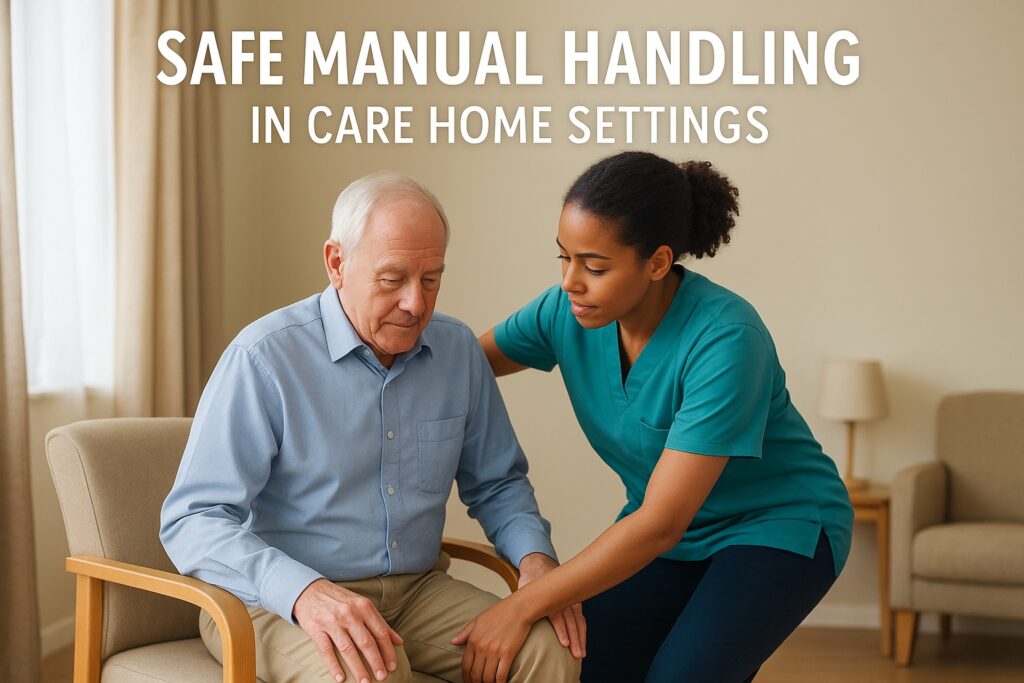
Manual handling is a critical skill for anyone working in health and social care. Every day, care workers, nurses, physiotherapists, and support staff carry out tasks that involve moving or assisting people and objects. Done incorrectly, these tasks can cause serious injuries—not only to staff but also to the people receiving care.
This blog post brings together essential knowledge on manual handling, based on accredited training materials and the latest UK regulations. It is designed to give you a clear understanding of best practices, common risks, and the role of ergonomics and equipment in keeping everyone safe.
🌍 Why Manual Handling Matters
High risk in health and social care: According to the Health and Safety Executive (HSE), moving and handling injuries account for 40% of work-related sickness absence in this sector.
Thousands of cases each year: Around 5,000 injuries in health services and 2,000 in social care are reported annually.
Impact on staff and patients: Poor manual handling can lead to back pain, long-term musculoskeletal disorders, and distress or discomfort for patients.
The statistics are clear: learning and applying safe manual handling practices is not optional—it’s essential.
🎯 Aims of Safe Manual Handling Training
By the end of a full training programme, you should be able to:
✔ Understand injuries that arise from poor lifting and moving techniques.
✔ Know the legal requirements and your responsibilities.
✔ Apply good lifting, moving, and assisting techniques.
✔ Handle people with respect, dignity, and safety—including bariatric care.
✔ Recognise the role of ergonomics and equipment in reducing risk.
✔ Access further guidance and professional resources.
🦴 Common Injuries from Poor Manual Handling
Manual handling can cause both external injuries (cuts, bruises, crush injuries) and internal injuries that are often more serious.
Muscular strain – fatigue and pain from static or awkward positions.
Torn ligaments & sprains – when joints are forced beyond their range.
Tendon injuries – leading to inflammation or rupture.
Cartilage damage – slow-healing joint issues like knee or spinal pain.
Hernias – from lifting with poor posture.
Prolapsed discs (slipped discs) – causing severe pain or partial paralysis.
Sciatica – nerve pain radiating from the lower back down the leg.
👉 Prevention is always better than cure. Once injured, recovery can be slow and may permanently affect your ability to work.
⚖️ The Law and Your Responsibilities
UK legislation provides a clear framework for safe manual handling. Key laws include:
Health and Safety at Work Act 1974 – Employers must ensure workers’ safety “as far as is reasonably practicable.”
Manual Handling Operations Regulations 1992 (amended 2002) – Requires avoiding hazardous manual handling where possible, assessing unavoidable risks, and reducing them.
Provision and Use of Work Equipment Regulations 1998 (PUWER) – Ensures equipment is safe, maintained, and used correctly.
Lifting Operations and Lifting Equipment Regulations 1998 (LOLER) – Covers safe use of lifting equipment like hoists.
RIDDOR 1995 – Injuries must be reported.
Equality Act 2010 – Protects dignity and rights when handling people.
Employees must also play their part: follow training, use equipment properly, co-operate with policies, and report unsafe practices.
🛠️ Risk Assessments: The TILE(O) Framework
Before carrying out any manual handling task, consider:
Task – Does it involve twisting, reaching, or long carrying distances?
Individual – Does the worker have the strength, health, or training for the task?
Load – Is it heavy, unstable, sharp, or awkward?
Environment – Slippery floors, poor lighting, or tight spaces?
Other factors – Time pressure, poor communication, or inadequate equipment.
Risk assessments must be documented, regularly reviewed, and adapted if circumstances change.
🏋️ Biomechanics and Safe Techniques
Your body works like a system of levers. Poor posture dramatically increases the forces on your spine.
Key principles:
Plan the lift—remove barriers and know where you’re going.
Keep loads close to your body and at waist height.
Bend at the hips and knees, not just the back.
Avoid twisting and jerky movements.
Push rather than pull where possible.
Ask for help with heavy or awkward loads.
👉 HSE guidelines set recommended weight limits (lower for women, reduced further if twisting, repetitive, or working at speed).
🤝 Moving and Handling People
This is often more complex than moving objects because people are heavy, may move unpredictably, and require dignity.
Agreed ways of working – Follow the care plan.
Look, Ask, Demonstrate (LAD) – Assess mobility by observation, asking the patient, and encouraging them to show what they can do.
Organisational policies – Some lifts are banned. Always check your workplace rules.
Respect and dignity – Protect privacy, explain every step, and involve the person in decisions.
Equipment that helps:
Slide sheets, transfer boards, hoists, slings, turntables, handling belts, lifting cushions.
Bariatric care:
Specialist training and equipment are needed for people with BMI > 40 or weight above 25 stone (160kg).
🚶 Handling Falls
Falls are one of the most common risks. Staff should know how to:
Prevent falls – remove hazards, use non-slip footwear, provide mobility aids.
Assist safely – by lowering, redirecting, or stabilising without risking your own health.
Follow care plans – documenting risks and strategies.
🛋️ Ergonomics in Care Settings
Ergonomics is about designing workspaces and equipment to reduce fatigue and injury. In healthcare, this might mean:
Wider doorways and turning space for wheelchairs and hoists.
Adjustable profiling beds.
Proper lighting, temperature, and noise control.
Specialist bariatric suites with overhead hoists.
📚 Continuing Professional Development
Safe manual handling isn’t a “one-time” skill. Training must be refreshed regularly and complemented by hands-on practice. Recommended resources include:
HSE guidance: hse.gov.uk
Backcare – The Guide to Handling People (HOP6)
Skills for Care standards
Practical training by St John Ambulance
📝 Final Thoughts
Manual handling is more than a workplace requirement—it’s about protecting your own health and ensuring dignity and safety for those you care for. With the right knowledge, careful planning, and proper use of equipment, you can prevent injuries and provide better care.
